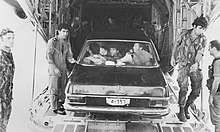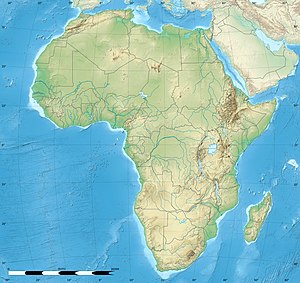Our website is made possible by displaying online advertisements to our visitors.
Please consider supporting us by disabling your ad blocker.
Entebbe raid
| Operation Thunderbolt | |||||||
|---|---|---|---|---|---|---|---|
| Part of the Arab–Israeli conflict and the Cold War | |||||||
 Israeli commandos with a Mercedes-Benz 600 resembling the one owned by Ugandan dictator Idi Amin, used by Sayeret Matkal to deceive Ugandan troops during the raid[1] | |||||||
| |||||||
| Belligerents | |||||||
|
Supported by: |
| ||||||
| Commanders and leaders | |||||||
| Strength | |||||||
| c. 100 Israeli commandos (plus aerial crew and support personnel) |
7 hijackers: 5 Palestinians, 2 Germans 100+ Ugandan soldiers | ||||||
| Casualties and losses | |||||||
|
1 killed (Y. Netanyahu) 5 wounded |
7 hijackers killed 45 soldiers killed[4] 11–30 Ugandan aircraft destroyed[5] | ||||||
|
4 hostages killed (incl. Dora Bloch)[6][7] 10 hostages wounded | |||||||
The Entebbe raid or Operation Entebbe, officially codenamed Operation Thunderbolt (retroactively codenamed Operation Yonatan), was a 1976 Israeli counter-terrorist mission in Uganda. It was launched in response to the hijacking of an international civilian passenger flight (an Airbus A300) operated by Air France between the cities of Tel Aviv and Paris. During a stopover in Athens, the aircraft was hijacked by two Palestinian PFLP–EO and two German RZ members,[8] who diverted the flight to Libya and then to Uganda, where they landed at Entebbe International Airport to be joined by other terrorists. Once in Uganda, the group enjoyed support from Ugandan dictator Idi Amin.[9]
A week earlier, on 27 June, an Air France Airbus A300 jet airliner with 248 passengers had been hijacked by two members of the Popular Front for the Liberation of Palestine – External Operations (PFLP-EO) under orders of Wadie Haddad (who had earlier broken away from the PFLP of George Habash),[8] and two members of the German Revolutionary Cells. The hijackers took hostages with the stated objective of compelling the release of 40 Palestinian and affiliated militants imprisoned in Israel as well as the release of 13 prisoners in four other countries.[10] Over 100 Ugandan soldiers were deployed to support the hijackers after the flight landed, and Amin, who had been informed of the hijacking from the beginning,[11] had personally welcomed the terrorists at Entebbe.[12] After moving all of the hostages to a defunct airport, the hijackers separated all Israelis and several non-Israeli Jews from the larger group of passengers, subsequently moving them into a separate room.[13][14][15] Over the next two days, 148 non-Israeli hostages were released and flown out to Paris.[14][15][16] The 94 remaining passengers, most of whom were Israelis, and the 12-member Air France crew continued to be held as hostages.[17][18]
Representatives within the Israeli government initially debated over whether to concede or respond by force, as the hijackers had threatened to kill the 106 captives if the specified prisoners were not released. Acting on intelligence provided by Mossad, the decision was made to have the Israeli military undertake a rescue operation.[19] The Israeli plans included preparation for an armed confrontation with Amin's Uganda Army.[20]
Initiating the operation at nightfall on 3 July 1976, Israeli transport planes flew 100 commandos over 4,000 kilometres (2,500 mi) to Uganda for the rescue effort. Over the course of 90 minutes, 102 of the hostages were rescued successfully, with three having been killed. One of the dead hostages, Dora Bloch, was murdered by Ugandan authorities at a hospital in Kampala shortly after the Israeli rescue operation; she had fallen ill during the hijacking and was removed from the plane for treatment prior to the commandos' arrival. The Israeli military suffered five wounded and one killed; Yonatan Netanyahu was Israel's sole fatality of Operation Entebbe, and had led Sayeret Matkal during the rescue effort – he was the older brother of Benjamin Netanyahu, who would later become Israel's prime minister.[21] The Israeli commandos killed all of the hijackers and 45 Ugandan soldiers, and 11 of Uganda's[6][7] MiG-17s and MiG-21s were destroyed.[5] Over the course of the operation in Uganda, Israel received support from neighbouring Kenya. Idi Amin subsequently issued orders for the Ugandan army to kill all Kenyans living in Uganda,[22] leading to the deaths of 245 Kenyan-Ugandans and the exodus of around 3000 Kenyans from Uganda.[23]
- ^ Times, Terence Smith Special to The New York (13 July 1976). "Israelis Say Raider Impersonated Amin". The New York Times. ISSN 0362-4331. Retrieved 5 October 2023.
- ^ McRaven, Bill. "Tactical Combat Casualty Care – November 2010". MHS US Department of Defense. Archived from the original on 16 May 2011. Retrieved 15 July 2011.
- ^ 1976: Israelis rescue Entebbe hostages, BBC
- ^ Dunstan, Simon (2011). Entebbe: the most daring raid of Israel's special forces. The most daring raids in history. New York: Rosen Pub. ISBN 978-1-4488-1868-6. OCLC 649079751.
- ^ a b Brzoska, Michael; Pearson, Frederic S. (1994). Arms and warfare: escalation, de-escalation, and negotiation. Studies in international relations. Columbia, S.C: University of South Carolina Press. ISBN 978-0-87249-982-9.
- ^ a b "Entebbe raid". Encyclopædia Britannica. 26 June 2023.
- ^ a b "BBC on This Day – 4 – 1976: Israelis rescue Entebbe hostages". BBC News.
- ^ a b Cite error: The named reference
Hartuvwas invoked but never defined (see the help page). - ^ Smith, Terence (4 July 1976). "Hostages Freed as Israelis Raid Uganda Airport; Commandos in 3 Planes Rescue 105-Casualties Unknown Israelis Raid Uganda Airport And Free Hijackers' Hostages". The New York Times. Retrieved 4 July 2009.
- ^ "Hijacking of Air France Airbus by Followers of Popular Front for the Liberation of Palestine – Israeli Action to liberate Hostages held at Entebbe Airport ..." (PDF). Keesing's Record of World Events. 22: 27888. August 1976. Retrieved 23 September 2014.
- ^ Furst, Alan (2016). "'Operation Thunderbolt,' by Saul David". The New York Times. ISSN 0362-4331. Retrieved 8 January 2018.
- ^ "Idi Amin's Son: My Dream Is to Apologize Personally to Family of Entebbe Victims". Ha'aretz. 14 June 2016.
- ^ Cite error: The named reference
Freed Hostages Tell Their Storywas invoked but never defined (see the help page). - ^ a b Dunstan, Simon (2011). Entebbe: The Most Daring Raid of Israel's Special Forces. The Rosen Publishing Group. pp. 20–24. ISBN 978-1-4488-1868-6. Retrieved 4 July 2012.
- ^ a b Ensalaco, Mark (2008). Middle Eastern Terrorism: From Black September to September 11. University of Pennsylvania Press. pp. 96–. ISBN 978-0-8122-4046-7. Retrieved 4 July 2012.
- ^ "Entebbe; Thirty Years On; miracle on the runway". Jewish Telegraph. 2006. Retrieved 20 June 2011.
- ^ Scharfstein, Sol (1994). Understanding Israel. KTAV Publishing House, Inc. pp. 118–. ISBN 978-0-88125-428-0. Retrieved 5 July 2012.
- ^ Dunstan, Simon (2009). Israel's Lighting Strike, The raid on Entebbe 1976. Osprey Publishing; Osprey Raid Series No. 2. p. 24. ISBN 978-1-84603-397-1.
- ^ "Mossad took photos, Entebbe Operation was on its way". Ynetnews. 2006. Retrieved 6 July 2009.
- ^ Feldinger, Lauren Gelfond (29 June 2006). "Back to Entebbe". The Jerusalem Post. Retrieved 4 July 2009.
- ^ "Operation Entebbe". The Knesset at Sixty. Retrieved 4 July 2009.
- ^ Bayerlin, Ulrich (1977). "Abhandlungen: Die israelische Befreiungsaktion von Entebbe in völkerrechtlicher Sicht" [Essays: The Israeli liberation operation of Entebbe from an international law perspective] (PDF). zaoerv.de (in German). Max Planck Institute for Comparative Public Law and International Law.
- ^ Cite error: The named reference
Keesing27891was invoked but never defined (see the help page).
Previous Page Next Page



